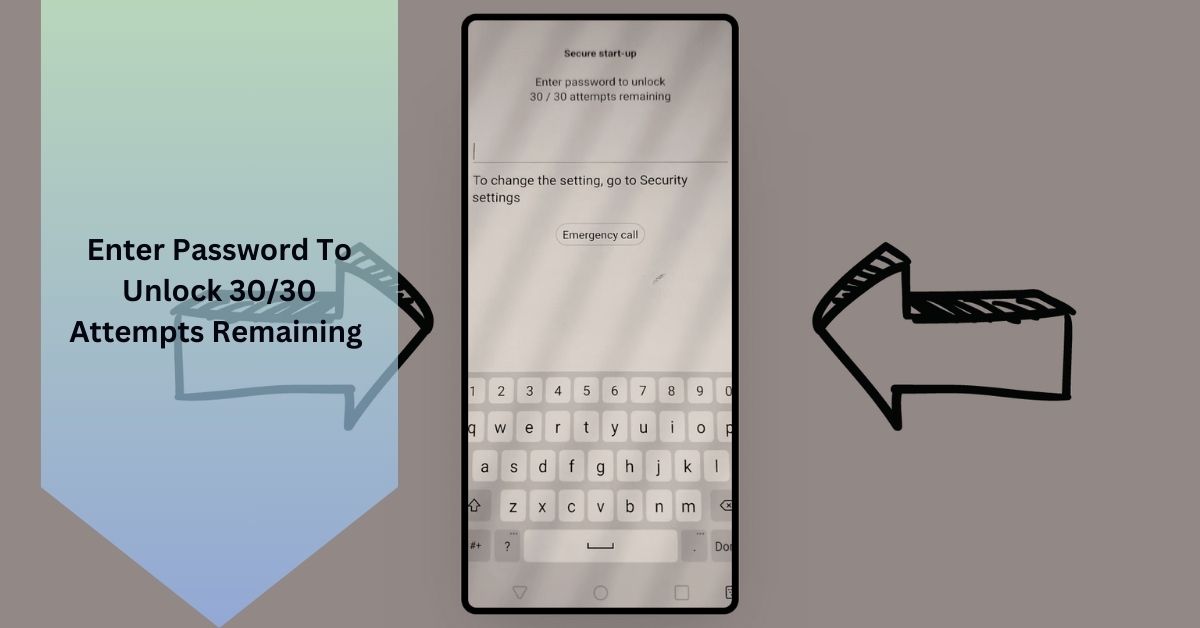Enter Password To Unlock 30/30 Attempts Remaining – Read It!
Unlocking Your Device – Understanding the Attempt Limit!
Unlocking your device can sometimes be stressful, especially when you see a message like “Enter Password to Unlock 30/30 Attempts Remaining.” Understanding this message and how to avoid potential lockouts is crucial for maintaining access to your device without unnecessary hassles.
This guide will walk you through what this message means, why there is a limit on password attempts, and what you can do to avoid reaching that limit.
What Does “30/30 Attempts Remaining” Mean?

The “30/30 Attempts Remaining” message indicates that you have a total of 30 attempts to enter the correct password before your device enforces additional security measures.
Each incorrect attempt decreases the count, and the message will update accordingly (e.g., “Enter Password to Unlock 29/30 Attempts Remaining”). This counter helps prevent unauthorized access and safeguards your personal information.
Why is There a Limit on Password Attempts?
Password attempt limits are a security feature designed to protect your device from brute force attacks. Brute force attacks involve systematically entering different passwords until the correct one is found.
By restricting the number of attempts, your device ensures that only authorized users can access its contents, making it significantly harder for someone to guess your password through repeated trials. This limit also serves as a deterrent to would-be intruders, adding an extra layer of security to your device.
Also Read: David Sacks Net Worth – A Closer Look!
What Happens If I Reach the Limit?
Reaching the limit of 30 incorrect password attempts triggers various security measures depending on your device’s settings. In some cases, your device might temporarily lock you out, requiring a waiting period before you can try again.
This temporary lockout frustrates potential intruders, making it harder for them to continue their attempts. In more severe cases, reaching the attempt limit might result in a permanent lockout, necessitating a factory reset. A factory reset erases all data, restoring the device to its original settings, which means losing all personal data unless it has been backed up.
Additionally, some devices might prompt for additional security verification, such as entering a recovery code, verifying identity through linked accounts, or answering security questions, ensuring that only the rightful owner can regain access.
How Can I Avoid Reaching the Limit?
To avoid reaching the password attempt limit and potentially locking yourself out of your device, it is essential to follow best practices. First, use a strong, memorable password that is difficult to guess but easy for you to remember.
Avoid common passwords like “123456” or “password.” Enabling biometric authentication, such as fingerprint or facial recognition, can significantly reduce the need for frequent password entries, enhancing both security and convenience.
Utilizing a password manager to securely store and autofill your passwords can also help in preventing multiple incorrect entries. When you forget your password, take a moment to think rather than hurriedly entering guesses.
Regularly backing up your data to a secure location ensures that you can restore it if you ever need to perform a factory reset due to a lockout.
Table: Possible Outcomes After Reaching the Limit
| Attempt Limit Reached | Possible Outcome |
| 30/30 | Temporary Lockout |
| 30/30 | Permanent Lockout |
| 30/30 | Additional Verification |
Key Takeaways:
Understanding the attempt limit for unlocking your device is essential for maintaining access and ensuring security. Here are the key points to remember:
- 30/30 Attempts: You have 30 chances to enter the correct password.
- Security Feature: The limit protects against unauthorized access.
- Consequences: Reaching the limit can result in temporary or permanent lockout.
- Prevention: Use strong passwords, enable biometric authentication, and consider a password manager.
Understanding Android Lockout Messages:

Android devices use various lockout messages to inform users about their current security status. Knowing the difference between these messages can help you manage your device effectively.
Conceptualizing Lockout Messages:
Lockout messages are designed to provide clear information on your remaining attempts to unlock your device. They serve as a reminder to be cautious and deliberate when entering your password.
Differentiating 0/30 and 30/30 Messages:
- 0/30 Attempts Remaining: Indicates that you have exhausted all attempts and may face a lockout. This message is a warning that any further incorrect attempts will likely result in a lockout, necessitating additional steps to regain access.
- 30/30 Attempts Remaining: Indicates that you have all 30 attempts left, typically seen after a reset or initial setup. This message reassures you that you have the full set of attempts to enter your password correctly.
Understanding these messages helps you better manage your password entries and avoid unnecessary lockouts.
FAQ’s:
1. What does “Enter Password to Unlock 30/30 Attempts Remaining” mean?
This message means you have 30 attempts to correctly enter your password before your device enforces additional security measures.
2. Why is there a limit on password attempts?
The limit is a security feature to protect against brute force attacks, ensuring that only authorized users can access the device.
3. What happens if I reach the 30/30 attempt limit?
Reaching the limit can trigger temporary or permanent lockouts or require additional security verification like a recovery code or linked account verification.
4. How can I avoid reaching the attempt limit?
Use a strong, memorable password, enable biometric authentication, utilize a password manager, and regularly back up your data.
5. What is a temporary lockout?
A temporary lockout is when the device locks you out for a specific period, preventing any further password attempts during that time.
6. What is a permanent lockout?
A permanent lockout occurs when the device requires a factory reset to regain access, which erases all data unless it has been backed up.
Conclusion:
Understanding the “Enter Password to Unlock 30/30 Attempts Remaining” message is crucial for maintaining access to your device and ensuring its security. By knowing the implications of the attempt limit, using strong passwords, and enabling additional security features, you can protect your device from unauthorized access. Stay informed about your device’s security protocols to avoid frustrating lockouts and keep your data safe.
Read More:


![[noblocc] kicked for being afk](https://relictimes.com/wp-content/uploads/2024/11/image-ezgif.com-webp-to-jpg-converter-2024-11-20T140233.477-1.jpg)


![[noblocc] kicked for being afk](https://relictimes.com/wp-content/uploads/2024/11/image-ezgif.com-webp-to-jpg-converter-2024-11-20T140233.477-1-300x200.jpg)








Post Comment